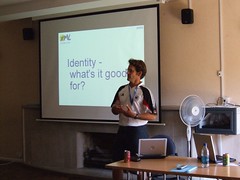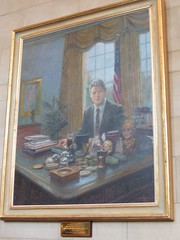The XML Summer School was quite the steamy experience this year. I’d ascribe it to global warming, except that last year’s final week in July was quite chilly. I believe it was at some point on the pub crawl when one of the locals in our delegation told me, in a moment of drunken honesty, that the same thing happens every year: The English forget it gets hot in summer and act all shocked when it happens.
Bob DuCharme writes here about his School experience. His track looked really great — I wish it weren’t opposite mine. But I did have a great time hanging out with Bob, Priscilla Walmsley, Jeni Tennison, and everyone else in the off-hours. As Bob describes, we squeezed in a singing-and-playing session outside the college bar, where I tried out my new roll-up piano for the first time. All in all, the keyboard…doesn’t entirely suck. Marc Hadley managed to capture a picture of the scene, along with some stunning Oxfordscapes (he’s a real photographer, unlike me).
At the Trends and Transients session, we added something new: all the track chairs had a chance to opine (rant?) briefly. Peter Flynn and Sean McGrath went back and forth on microformats; there was a great moment when Sean insisted, almost tenderly, that “Microformats are beautiful.” Peter shot back some advice on avoiding Tag Abuse, and advocated joining his SDATA club.
I got cute with the concept and spent my five minutes on Tr*: two Tropes, three Trends, two Transients, and a Transparent for the web services area. I think it was when I mentioned “architectures” as a Trope that Paul Downey (who took some wonderful photos himself) commented (slightly paraphrased), “Protocols are really difficult to write. Look at TCP/IP! Giving people ways to create new protocols is like giving children machine guns.” You go, Paul! If by architectures we mean the building of frameworks wherein people constantly have to invent new protocols to use them, I worry for the security of systems based on them.
The Transparent I mentioned was “policy”. Technology is rarely more than 30% of a solution, with governance, policy, legal, and other messy human issues making up the rest, and yet many of us rush to work on the technology because it’s cool and it’s tractable. I’ve seen this done recently by people who really should know better.
I’m insanely biased, of course, but I thought my track rocked. I hope my illustrious speakers don’t take this the wrong way, but I thought we achieved many moments of actual edutainment. A few highlights:
-
Sean made a compelling argument for temporal decoupling in service development, meaning asynchrony. If you agree with SPLJ but you accept too much coupling by pointing directly into business logic instead of into message queues/holding areas of some kind, what you’ve got is inherently brittle. Someone followed up on this point, noting that “Asynchronous programming is defensive programming.” Sean also noted that a staged event-driven architecture lets you do better load balancing. (This prompted me to mention something I heard Don Box say some years ago — the older distributed computing technologies tried to treat all the components as equally close together, whereas web services treats them as equally far apart. Perhaps this can’t be achieved without Sean’s approach.)
As part of this, he observed that mashups are great for information integration, but don’t seem to be so good for application integration. The transactions being done are all simply idempotent (Paul Downey preferred to say merely “safe”) GETs, and yet the results are powerful. I wonder what the next huge enterprise SOA would look like if it strove for SPLJ in this fashion…
-
Robin Wilton, in discussing the notions of reputation vs. identity, pointed out that privacy features of a system can prevent your ability to make a determination that two digital identities correlate to the same person, which can mess up reputation systems.
-
John Kemp noted that “The web of services is not just a web of servers”, on his way to demonstrating, live, how a mobile client device (Nokia, natch) could host an attribute service about you.
-
Paul Madsen‘s talk managed to flow seamlessly from beer, to identity services, to “plumber’s crack”. :-)
Finally, here’s a portrait of Bill Clinton that hangs in the Rhodes House, taken at one of the evening events. If you want to get a closer look at Bill Clinton and what are apparently his favorite objects, go ahead, click…you know you want to.







*Tab* Abuse? :-) The carbonated drink, the white-space character, or the check in a restaurant?
Arrgghh! Will fix that! How did I miss it??
People don’t abuse Tab(tm), Tab abuses people…